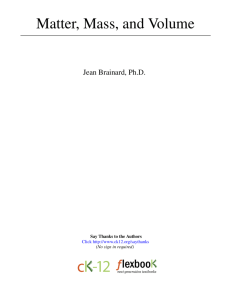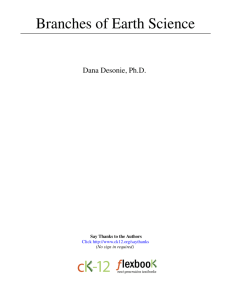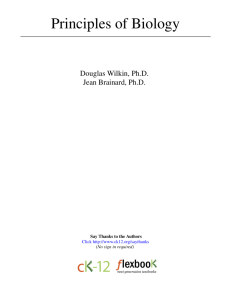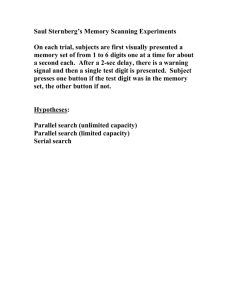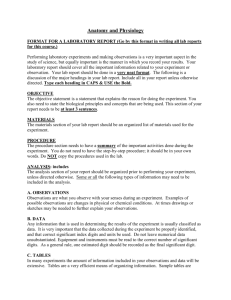Significant Figures
advertisement
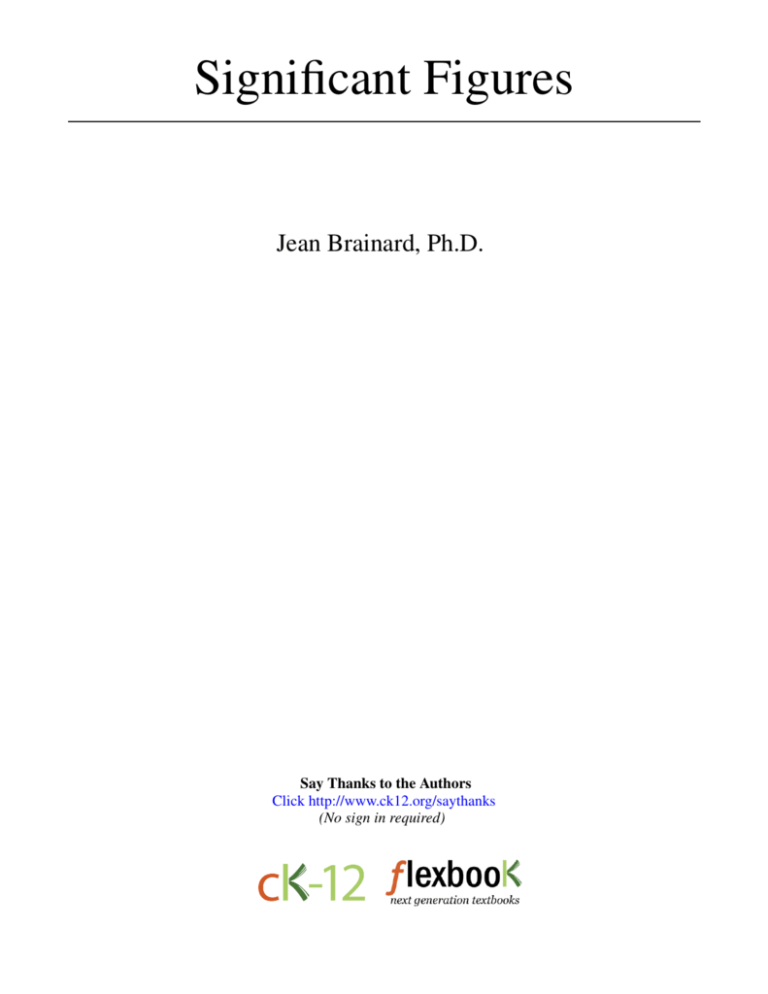
Significant Figures Jean Brainard, Ph.D. Say Thanks to the Authors Click http://www.ck12.org/saythanks (No sign in required) To access a customizable version of this book, as well as other interactive content, visit www.ck12.org CK-12 Foundation is a non-profit organization with a mission to reduce the cost of textbook materials for the K-12 market both in the U.S. and worldwide. Using an open-content, web-based collaborative model termed the FlexBook®, CK-12 intends to pioneer the generation and distribution of high-quality educational content that will serve both as core text as well as provide an adaptive environment for learning, powered through the FlexBook Platform®. Copyright © 2013 CK-12 Foundation, www.ck12.org The names “CK-12” and “CK12” and associated logos and the terms “FlexBook®” and “FlexBook Platform®” (collectively “CK-12 Marks”) are trademarks and service marks of CK-12 Foundation and are protected by federal, state, and international laws. Any form of reproduction of this book in any format or medium, in whole or in sections must include the referral attribution link http://www.ck12.org/saythanks (placed in a visible location) in addition to the following terms. Except as otherwise noted, all CK-12 Content (including CK-12 Curriculum Material) is made available to Users in accordance with the Creative Commons Attribution-Non-Commercial 3.0 Unported (CC BY-NC 3.0) License (http://creativecommons.org/ licenses/by-nc/3.0/), as amended and updated by Creative Commons from time to time (the “CC License”), which is incorporated herein by this reference. Complete terms can be found at http://www.ck12.org/terms. Printed: October 11, 2013 AUTHOR Jean Brainard, Ph.D. www.ck12.org C ONCEPT • • • • Concept 1. Significant Figures 1 Significant Figures Define significant figures. State rules for counting significant figures. Explain how to determine significant figures in calculations. Identify rules for rounding numbers. Jerod has a homework problem that involves finding the area of a rectangle. He knows that the area of a rectangle equals its length times its width. The rectangle in question has a length of 6.9 m and a width of 6.8 m, so he multiplies the two numbers on his calculator. The answer he gets is 46.92 m2 , which he records on his homework. To his surprise, his teacher marks this answer wrong. The reason? The answer has too many significant figures. What Are Significant Figures? In any measurement, the number of significant figures is the number of digits thought to be correct by the person doing the measuring. It includes all digits that can be read directly from the measuring device plus one estimated digit. Look at the sketch of a beaker in the Figure 1.1. How much blue liquid does the beaker contain? The top of the liquid falls between the mark for 40 mL and 50 mL, but it’s closer to 50 mL. A reasonable estimate is 47 mL. In this measurement, the first digit (4) is known for certain and the second digit (7) is an estimate, so the measurement has two significant figures. Now look at the graduated cylinder sketched in the Figure 1.2. How much blue liquid does it contain? First, it’s important to note that you should read the amount of liquid at the bottom of its curved surface. This falls about half way between the mark for 36 mL and the mark for 37 mL, so a reasonable estimate would be 36.5 mL. 1 www.ck12.org FIGURE 1.1 Q: How many significant figures does this measurement have? A: There are three significant figures in this measurement. You know that the first two digits (3 and 6) are accurate. The third digit (5) is an estimate. Rules for Counting Significant Figures The examples above show that it’s easy to count the number of significant figures when you are making a measurement. But what if someone else has made the measurement? How do you know which digits are known for certain and which are estimated? How can you tell how many significant figures there are in the measurement? There are several rules for counting significant figures: • Leading zeros are never significant. For example, in the number 006.1, only the 6 and 1 are significant. • Zeros within a number between nonzero digits are always significant. For example, in the number 106.1, the zero is significant, so this number has four significant figures. • Zeros that show only where the decimal point falls are not significant. For example, the number 470,000 has just two significant figures (4 and 7). The zeros just show that the 4 represents hundreds of thousands and the 7 represents tens of thousands. Therefore, these zeros are not significant. • Trailing zeros that aren’t needed to show where the decimal point falls are significant. For example, 4.00 has three significant figures. Q: How many significant figures are there in each of these numbers: 20,080, 2.080, and 2000? 2 www.ck12.org Concept 1. Significant Figures FIGURE 1.2 A: Both 20,080 and 2.080 contain four significant figures, but 2000 has just one significant figure. Determining Significant Figures in Calculations When measurements are used in a calculation, the answer cannot have more significant figures than the measurement with the fewest significant figures. This explains why the homework answer above is wrong. It has more significant figures than the measurement with the fewest significant figures. As another example, assume that you want to calculate the volume of the block of wood shown in the Figure 1.3. The volume of the block is represented by the formula: 3 www.ck12.org FIGURE 1.3 Volume = length × width × height Therefore, you would do the following calculation: Volume = 1.2 cm × 1.0 cm × 1 cm = 1.2 cm3 Q: Does this answer have the correct number of significant figures? A: No, it has too many significant figures. The correct answer is 1 cm3 . That’s because the height of the block has just one significant figure. Therefore, the answer can have only one significant figure. Rules for Rounding To get the correct answer in the volume calculation above, rounding was necessary. Rounding is done when one or more ending digits are dropped to get the correct number of significant figures. In this example, the answer was rounded down to a lower number (from 1.2 to 1). Sometimes the answer is rounded up to a higher number. How do you know which way to round? Follow these simple rules: • If the digit to be rounded (dropped) is less than 5, then round down. For example, when rounding 2.344 to three significant figures, round down to 2.34. • If the digit to be rounded is greater than 5, then round up. For example, when rounding 2.346 to three significant figures, round up to 2.35. • If the digit to be rounded is 5, round up if the digit before 5 is odd, and round down if digit before 5 is even. For example, when rounding 2.345 to three significant figures, round down to 2.34. This rule may seem arbitrary, but in a series of many calculations, any rounding errors should cancel each other out. Summary • In any measurement, the number of significant figures is the number of digits thought to be correct by the person doing the measuring. It includes all digits that can be read directly from the measuring device plus one estimated digit. 4 www.ck12.org Concept 1. Significant Figures • To determine the number of significant figures in a measurement that someone else has made, follow the rules for counting significant figures. • When measurements are used in a calculation, the answer cannot have more significant figures than the measurement with the fewest significant figures. • Rounding is done when one or more ending digits are dropped to get the correct number of significant figures. Simple rules state when to round up and when to round down. Vocabulary • significant figures: Correct number of digits in an answer that is based on the least precise measurement used in the calculation. Practice Do the significant figures quiz at this URL. Be sure to check your answers. http://www.sciencegeek.net/APchemistry/APtaters/sigfigs.htm Review 1. How do you determine the number of significant figures when you make a measurement? 2. Measure the width of a sheet of standard-sized (8.5 in x 11.0 in) loose-leaf notebook paper. Make the measurement in centimeters and express the answer with the correct number of significant figures. 3. How many significant figures do each of these measurements have? a. 0.04 b. 500 c. 1.50 4. In this calculation, how many significant figures should there be in the answer? 1.0234 + 1.1 + 0.0056 5. Round each of these numbers to three significant figures: a. 1258 b. 3274 c. 6845 References 1. CK-12 Foundation - Zachary Wilson. . CC-BY-NC-SA 3.0 2. CK-12 Foundation - Zachary Wilson. . CC-BY-NC-SA 3.0 3. CK-12 Foundation - Zachary Wilson. . CC-BY-NC-SA 3.0 5



